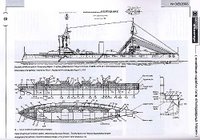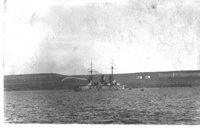Sunday Battleship Blogging: Volya
 Imperator Aleksandr III was the third of the Imperatritsa Mariya class, a group of dreadnoughts built in the Black Sea and designed to fight the Turkish Navy. Emperor Aleksandr III had succeeded to the throne of Russia upon the assassination of his brother in 1881. Although also the target of several assassination plots, Alexander III died of natural causes in 1894. A conservative, he helped roll back the reforms initiated by his father, and contributed in his own way to the revolutionary upheavels in Russia in the early twentieth century.
Imperator Aleksandr III was the third of the Imperatritsa Mariya class, a group of dreadnoughts built in the Black Sea and designed to fight the Turkish Navy. Emperor Aleksandr III had succeeded to the throne of Russia upon the assassination of his brother in 1881. Although also the target of several assassination plots, Alexander III died of natural causes in 1894. A conservative, he helped roll back the reforms initiated by his father, and contributed in his own way to the revolutionary upheavels in Russia in the early twentieth century.
Imperator Aleksandr III carried 12 12″ guns in four centerline, flush triple turrets. She displaced 24000 tons and could make 22 knots. The design was similar to but a moderate improvement upon the Gangut class, carrying much heavier armor. Because of an obdurate Turkish government, the Black Sea Fleet was the only Russian fleet, following the Russo-Japanese War, to still possess ships. The Turkish purchases of the dreadnoughts Sultan Osman I and Reshadiye (later Agincourt and Erin) would have given the Turks decisive superiority over the five remaining Russian pre-dreadnoughts. Imperator Aleksandr III and her sisters were designed to remedy this problem. Of course, the seizure of the two Turkish battleships by the British government and the later transfer of the German battlecruiser Goeben to Turkish control meant that the situation was somewhat different than what had been expected. The completion of Aleksandr’s two sisters would briefly give the Russian Navy superiority in the Black Sea in World War I, although the unfortunate explosion of Imperatritsa Mariya prevented the Russians from achieving dominance.
Aleksandr III was laid down in 1911, but because of slow Russian construction and problems with machinery delivery, was not complete by 1917. In February 1917 Russia went and had a revolution. Imperator Aleksandr III was taken over by the provisional government, and renamed Volya. Although still incomplete, she began to take her sea trials. A few months later, Volya was appropriated by one of the several independent Ukrainian governments that emerged in the wake of the Revolution. A few months after that, the inexorable advance of the Reichswehr left Germany in control of much of the Black Sea. The Treaty of Brest ceded control of Volya and her remaining sister to the Germans. The revolutionary crew of Svobodnaja Rossija (as Imperatritsa Ekaterina had been renamed) arranged the scuttling of their ship, but Volya was seized by the Germans, renamed Wolga, and commissioned (still incomplete) into the German Navy on October 15, 1918.
Germany surrendered on November 11, 1918, and the German fleet was ceded to British control. The British did not want the Bolsheviks to have access to Wolga, so moved  her (under Royal Navy flag) to Izmir. British, French, American, and Japanese policy in 1919 was to strangle the Bolshevik Revolution in its crib. The British turned Wolga over to White Russian forces, which completed the ship and renamed her General Alekseev, after the Imperial and counter-revolutionary Russian General Mikhail Alekseev. General Alekseev conducted bombardment operations against Bolshevik forces in the Black Sea area until mid 1920, when Red forces crushed White resistance in the Crimea. In November 1920, fleeing from the Bolshevik tyranny, the last Imperial Navy battleship, General Alekseev, led a ragtag, fugitive fleet on a lonely quest; a shining city named Bizerta. Thousands of Whites who could not fit on the Russian or accompanying British ships were massacred by the Red Army.
her (under Royal Navy flag) to Izmir. British, French, American, and Japanese policy in 1919 was to strangle the Bolshevik Revolution in its crib. The British turned Wolga over to White Russian forces, which completed the ship and renamed her General Alekseev, after the Imperial and counter-revolutionary Russian General Mikhail Alekseev. General Alekseev conducted bombardment operations against Bolshevik forces in the Black Sea area until mid 1920, when Red forces crushed White resistance in the Crimea. In November 1920, fleeing from the Bolshevik tyranny, the last Imperial Navy battleship, General Alekseev, led a ragtag, fugitive fleet on a lonely quest; a shining city named Bizerta. Thousands of Whites who could not fit on the Russian or accompanying British ships were massacred by the Red Army.
General Alekseev made its way to Bizerta, in the French colony of Tunisia. Alekseev was interned there by the French until 1924, when France officially gave up its baby strangling policy and recognized the Soviet Union. The French offered Alekseev to the Soviets, but the offer was refused because of the poor state of the ship. The reasons for the Soviet refusal are unclear, as it’s unlikely that General Alekseev was in any worse shape than Sevastopol and her sisters in the Baltic. In any case, the French kept General Alekseev, and slowly scrapped her at Bizerta over the course of the next twelve years. One of her main turrets was used as coastal defense artillery in World War II.
Trivia: What class of American battleships had the highest design displacement prior to the Iowa class?


